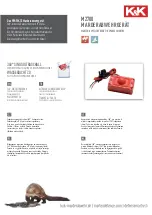
19
Table 1 Controller Front Panel
Item
Name
Function
1
LED Display
Main display field. Consists of eight 14-segment alpha-numeric 0.54
″
high red LED characters.
During normal operation, this field displays either the pH or mV value (depending on the mode of
operation selected). This field also displays menu messages, edit menu values, and error messages.
See
2
Secondary
Display Field
The secondary display field consists of three 7-segment numeric 0.3
″
high green LED digits.
During normal operation, this field displays temperature. In the setup menu, this field displays
abbreviations to help indicate which branch of the setup menu the operator is in. See
3
SETUP key
This key enters the setup menu. The setup is entered when it is pressed.
4
pH/mV key
During normal operation (instrument displaying pH/mV), this key toggles the reading between
pH and mV. If the instrument is in any of the menus, pressing this key returns the instrument to
normal operation.
5
ENTER key
This key, within the menus, either moves a level deeper into the menus, or accepts an edited selection.
6
CLEAR key
This key, within the menus, either clears changes in an edit portion of a menu, or backs up one menu
level. If this instrument is in an edit portion of a menu selection, and the value is changed, then this key
restores the original value. Otherwise, this key causes the menu selection to back up one level; if the
menu is at the top level, this key returns the instrument to normal operation (instrument
displaying pH/mV).
7
RIGHT
ARROW key
This key, in an edit portion of a menu selection, selects the next digit to the right to edit. The selected
digit flashes. When the instrument is in one of the non-editing portions of the calibration/setup menus,
or in normal operation (instrument displaying pH/mV), this key is not valid; if pressed, an INVALID
message flashes on the main display.
8
HOLD/DOWN
ARROW key
During normal operation (instrument displaying pH/mV), this key functions as a hold. When pressed,
the outputs (alarm relays, recorder, and controller outputs) alternately hold at the current value, or
release to normal operation. When the outputs are held, the first character in the main display
flashes an H. (
Note: The H appears only during normal operation; in the menus, the H does not
appear.) After the outputs are in the hold state for 30 minutes, they automatically release. When
the instrument is in one of the calibration/setup menus, this key scrolls down through the menu
selections. When the instrument is in an edit portion of a menu selection, this key decreases the
selected (flashing) digit.
9
ALARM ACK/
UP ARROW
key
During normal operation (instrument displaying pH/mV), this key functions as an alarm acknowledge.
When pressed, the alarms are alternately disabled or enabled. When the alarms are disabled, the
three alarm indicators flash, and the alarm relays are in the non-alarm state. After the alarms are
disabled for 30 minutes, they automatically enable. When the instrument is in one of the
calibration/setup menus, this key scrolls up through the menu selections. When the instrument is in an
edit portion of a menu selection, this key increases the selected (flashing) digit.
10
CAL key
This key enters the calibration menu. From this menu, the pH electrode, temperature probe, and mV
offset can be calibrated, and the calibration reviewed.
11
System warning Red LED. Indicates a probe failure or controller malfunction. Refer to Table 4 on page 42 for specific
system warnings that appear on the main LED display. For most system warnings, the user must query
the system to determine the warning. See
12
Alarm 2
Red LED. User programmable setpoint alarm. See
13
Alarm 1
Red LED. User programmable setpoint alarm. See
Summary of Contents for EC1000
Page 2: ...2...
Page 8: ...8...
Page 12: ...12...
Page 14: ...14...
Page 16: ...16...
Page 18: ...18 Figure 1 Controller Front Panel...
Page 20: ...20 Figure 2 Pump Module...
Page 24: ...24 Figure 6 pH Control Loop...
Page 54: ...54...
Page 56: ...56...
Page 58: ...58 Figure 12 Controller Installation Panel Mount...
Page 61: ...61 Figure 15 Installing the pH ORP Electrode Figure 16 Flow Thru Cell...
Page 70: ...70...
Page 73: ...73 6 4 Calibration See Section 2 3 Calibration Figure 21 Priming Tee Operation...
Page 74: ...74...
Page 80: ...80...
Page 83: ...83 Figure 24 Sensor Replacement...
Page 85: ...85 Figure 25 Hach One pH Process Electrode...
Page 89: ...89 Figure 26 Pump Module Plumbing Diagram...
Page 102: ...102...
Page 103: ......
Page 104: ......
Page 105: ......
Page 106: ......
Page 108: ...108...
Page 112: ...112...
Page 116: ...116...
Page 122: ...122...
Page 123: ...123...
Page 124: ......
















































